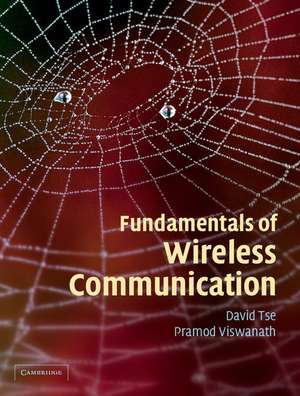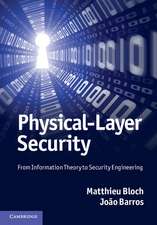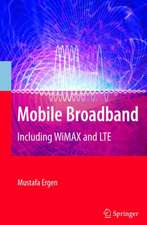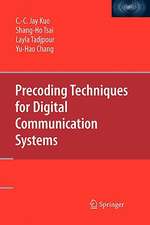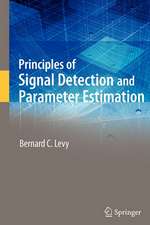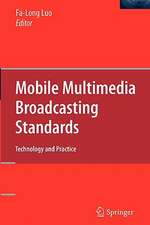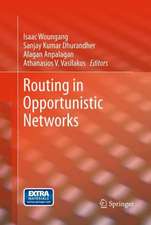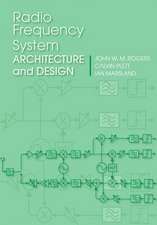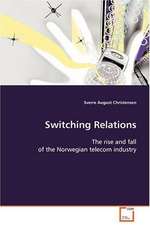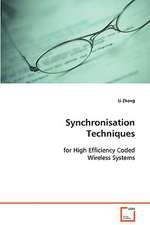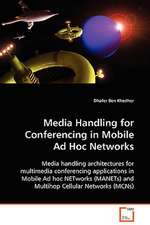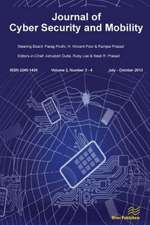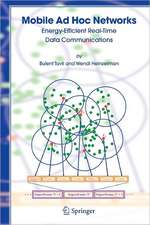Fundamentals of Wireless Communication
Autor David Tse, Pramod Viswanathen Limba Engleză Hardback – 25 mai 2005
Preț: 490.32 lei
Preț vechi: 532.96 lei
-8% Nou
Puncte Express: 735
Preț estimativ în valută:
93.83€ • 100.33$ • 78.23£
93.83€ • 100.33$ • 78.23£
Carte disponibilă
Livrare economică 27 martie-10 aprilie
Livrare express 13-19 martie pentru 66.13 lei
Preluare comenzi: 021 569.72.76
Specificații
ISBN-13: 9780521845274
ISBN-10: 0521845270
Pagini: 583
Ilustrații: 203 b/w illus. 8 tables 237 exercises
Dimensiuni: 193 x 246 x 33 mm
Greutate: 1.45 kg
Editura: Cambridge University Press
Colecția Cambridge University Press
Locul publicării:Cambridge, United Kingdom
ISBN-10: 0521845270
Pagini: 583
Ilustrații: 203 b/w illus. 8 tables 237 exercises
Dimensiuni: 193 x 246 x 33 mm
Greutate: 1.45 kg
Editura: Cambridge University Press
Colecția Cambridge University Press
Locul publicării:Cambridge, United Kingdom
Cuprins
1. Introduction; 2. The wireless channel; 3. Point-to-point communication: detection, diversity and channel uncertainty; 4. Cellular systems: multiple access and interference management; 5. Capacity of wireless channels; 6. Multiuser capacity and opportunistic communication; 7. MIMO I: spatial multiplexing and channel modeling; 8. MIMO II: capacity and multiplexing architectures; 9. MIMO III: diversity-multiplexing tradeoff and universal space-time codes; 10. MIMO IV: multiuser communication; A. Detection and estimation in additive Gaussian noise; B. Information theory background.
Recenzii
'Tse and Viswanath achieve remarkable clarity in combining sound theoretical development, simple insights, and current practice into an integrated whole. Fundamentals of Wireless Communication will quickly become a classic, serving both as a reference and a textbook built on firm principles.' Professor Robert G. Gallager, MIT
'… a superb textbook covering the field of modern wireless communications. The book truly covers the fundamentals of a wireless system design and incorporates a lucid exposition of the most recent advances such as MIMO and opportunistic communication. The results are derived with exceeding clarity and often linked to an information theoretical framework, thus providing the reader with a clear understanding of optimal design choices for both point-to-point and multiple access wireless communication …'. Dr Roberto Padovani, CTO, Qualcomm Incorporated, San Diego
'Fundamentals of Wireless Communication is a terrific introduction to principles of physical-layer design for state-of-the-art wireless systems. It is a wonderful and much-needed resource for new graduate students and practicing professionals alike. Tse and Viswanath have written a text of enduring value.' Professor Gregory W. Wornell, MIT
'Fundamentals of Wireless Communication is a unique combination of engineering insight, theoretical vision and systems experience. This is the text I use to explain to graduate students how they should think about fading channels.' Professor Robert Calderbank, Princeton University
'… this is a book written by academics, primarily for graduate courses. The style fits that role perfectly. It is predominantly mathematical, often using the maths as part of its way to describe a concept. However, it is an improvement over many graduate texts. The style of writing is open and relaxed. There are many real world examples explaining how concepts are related in 2G and 3G systems. The use of illustrations is excellent and there are copious exercises at the end of each chapter … I think that as a graduate text this would be truly excellent …'. IEE Communications Engineer
'Tse's and Viswanath's book addresses the most current topics and presents results from recent years in radio communication theory. I strongly recommend this book for graduate students taking a course in wireless systems. The first four chapters can be recommended for use in an undergraduate course in wireless communications as well.' IEEE Communications Magazine
'This book is a highly readable and step-by-step introduction to wireless communications … I will recommend it to my MSc students.' The Times Higher Education Supplement
'… a superb textbook covering the field of modern wireless communications. The book truly covers the fundamentals of a wireless system design and incorporates a lucid exposition of the most recent advances such as MIMO and opportunistic communication. The results are derived with exceeding clarity and often linked to an information theoretical framework, thus providing the reader with a clear understanding of optimal design choices for both point-to-point and multiple access wireless communication …'. Dr Roberto Padovani, CTO, Qualcomm Incorporated, San Diego
'Fundamentals of Wireless Communication is a terrific introduction to principles of physical-layer design for state-of-the-art wireless systems. It is a wonderful and much-needed resource for new graduate students and practicing professionals alike. Tse and Viswanath have written a text of enduring value.' Professor Gregory W. Wornell, MIT
'Fundamentals of Wireless Communication is a unique combination of engineering insight, theoretical vision and systems experience. This is the text I use to explain to graduate students how they should think about fading channels.' Professor Robert Calderbank, Princeton University
'… this is a book written by academics, primarily for graduate courses. The style fits that role perfectly. It is predominantly mathematical, often using the maths as part of its way to describe a concept. However, it is an improvement over many graduate texts. The style of writing is open and relaxed. There are many real world examples explaining how concepts are related in 2G and 3G systems. The use of illustrations is excellent and there are copious exercises at the end of each chapter … I think that as a graduate text this would be truly excellent …'. IEE Communications Engineer
'Tse's and Viswanath's book addresses the most current topics and presents results from recent years in radio communication theory. I strongly recommend this book for graduate students taking a course in wireless systems. The first four chapters can be recommended for use in an undergraduate course in wireless communications as well.' IEEE Communications Magazine
'This book is a highly readable and step-by-step introduction to wireless communications … I will recommend it to my MSc students.' The Times Higher Education Supplement
Notă biografică
Descriere
A unified view of the fundamentals of wireless communication for graduate students and practising engineers.
